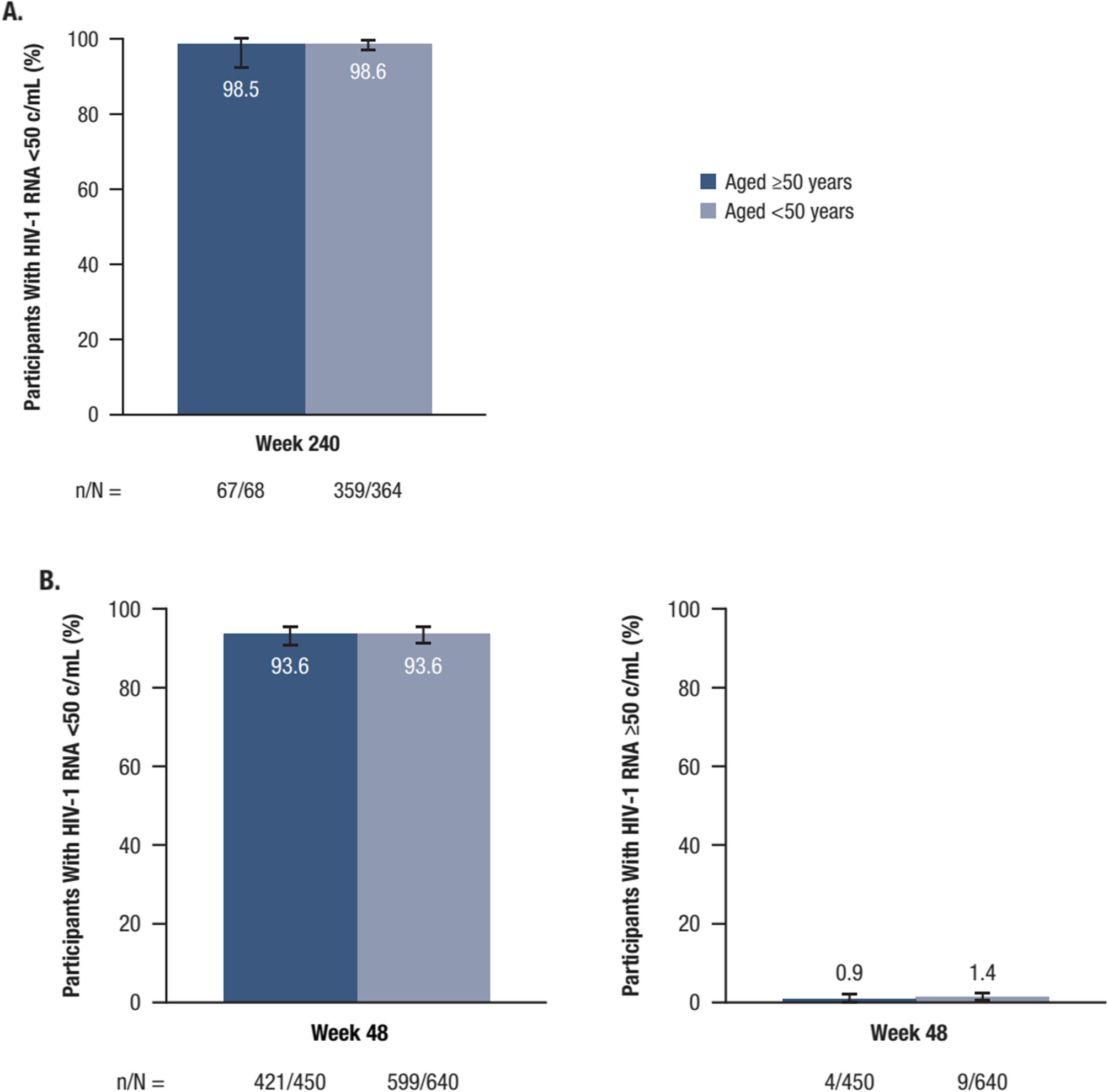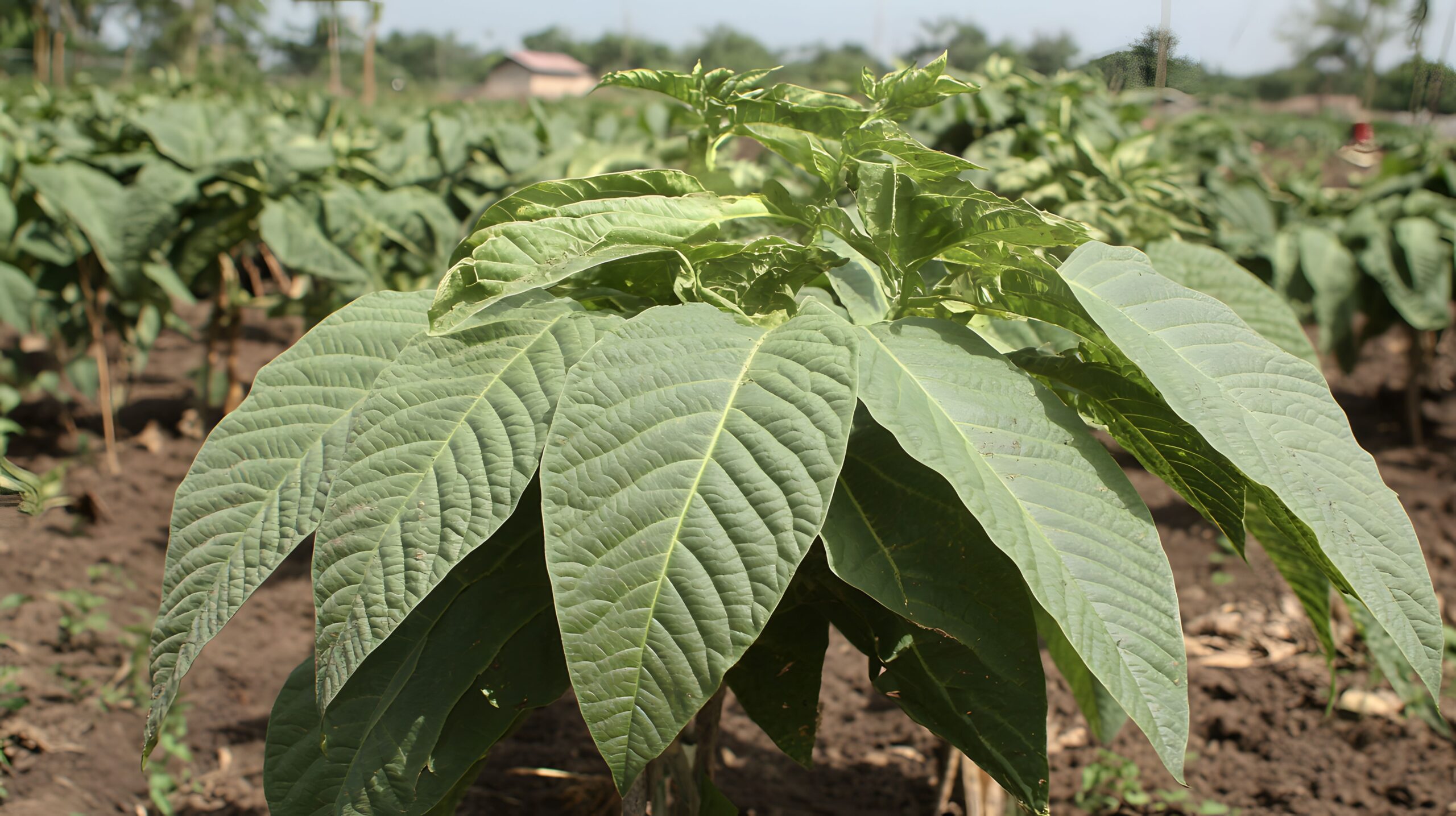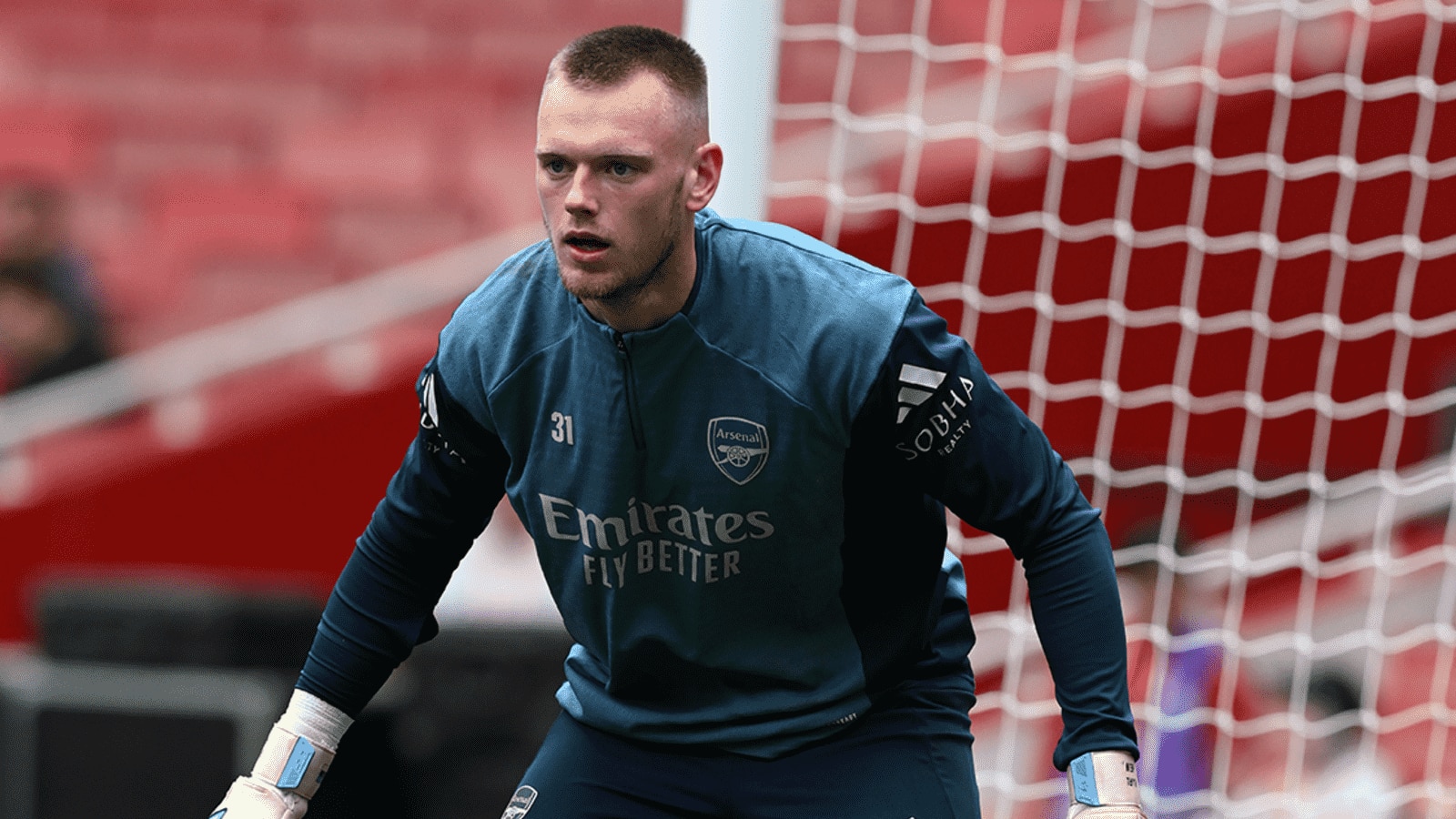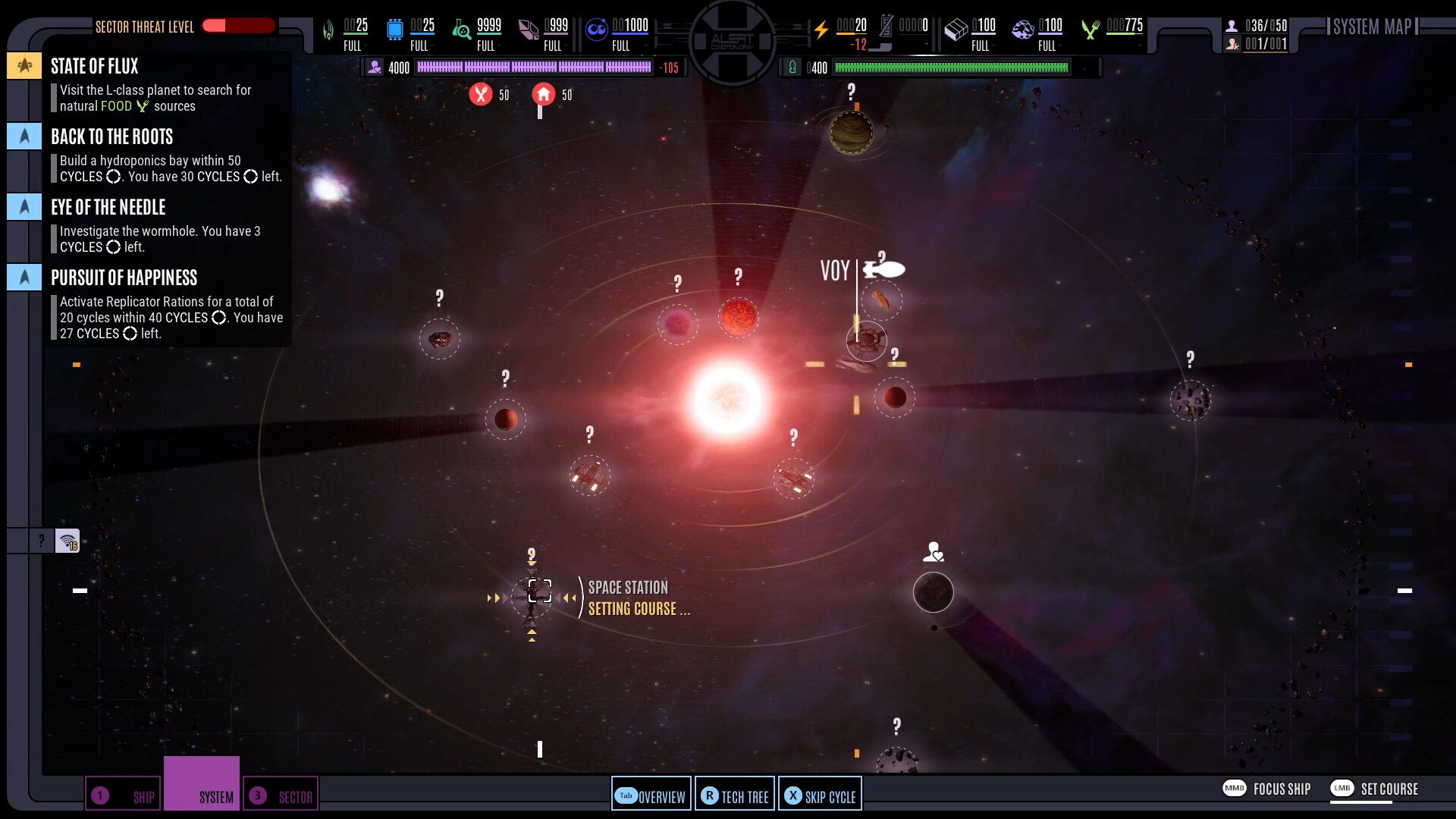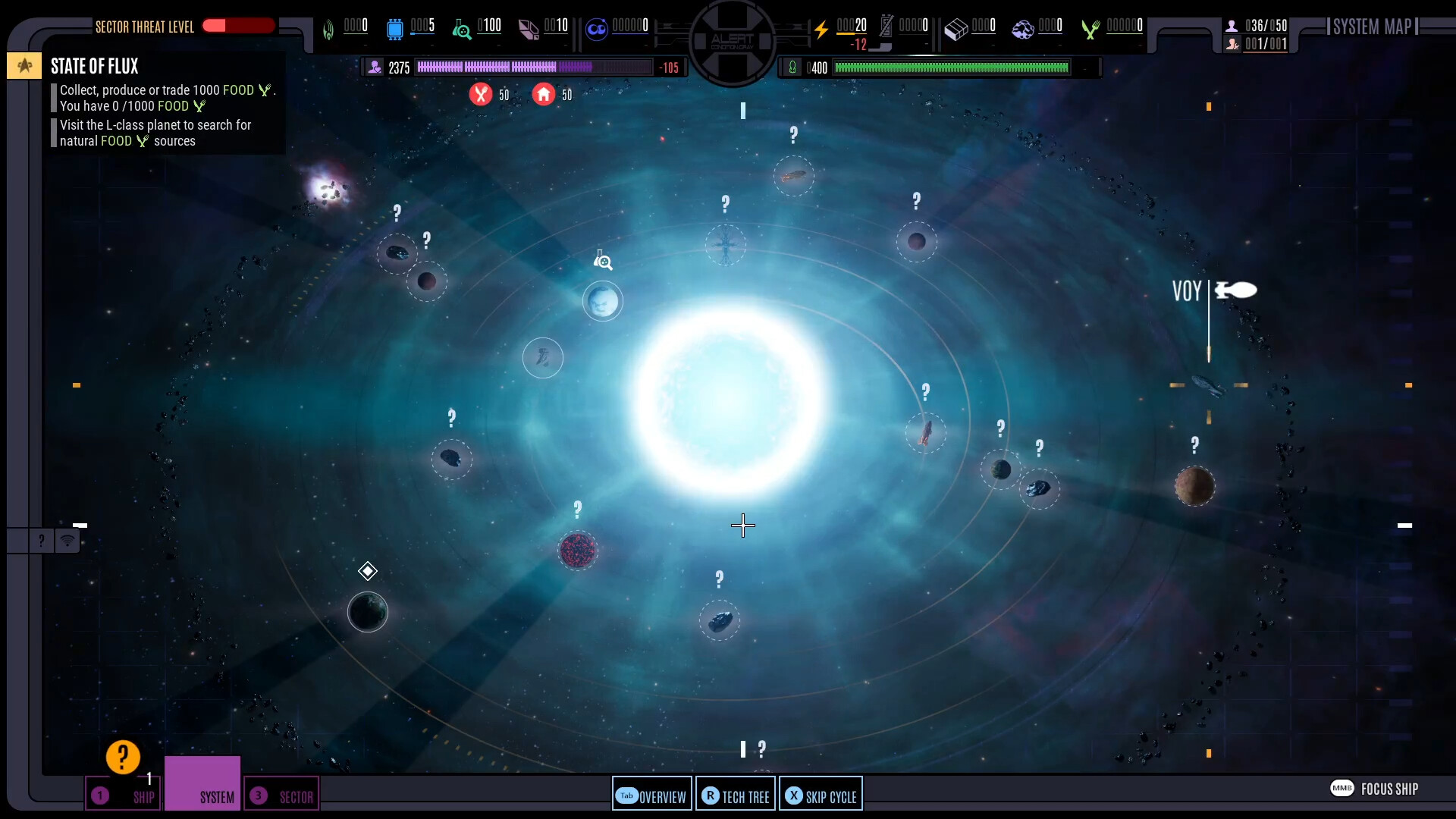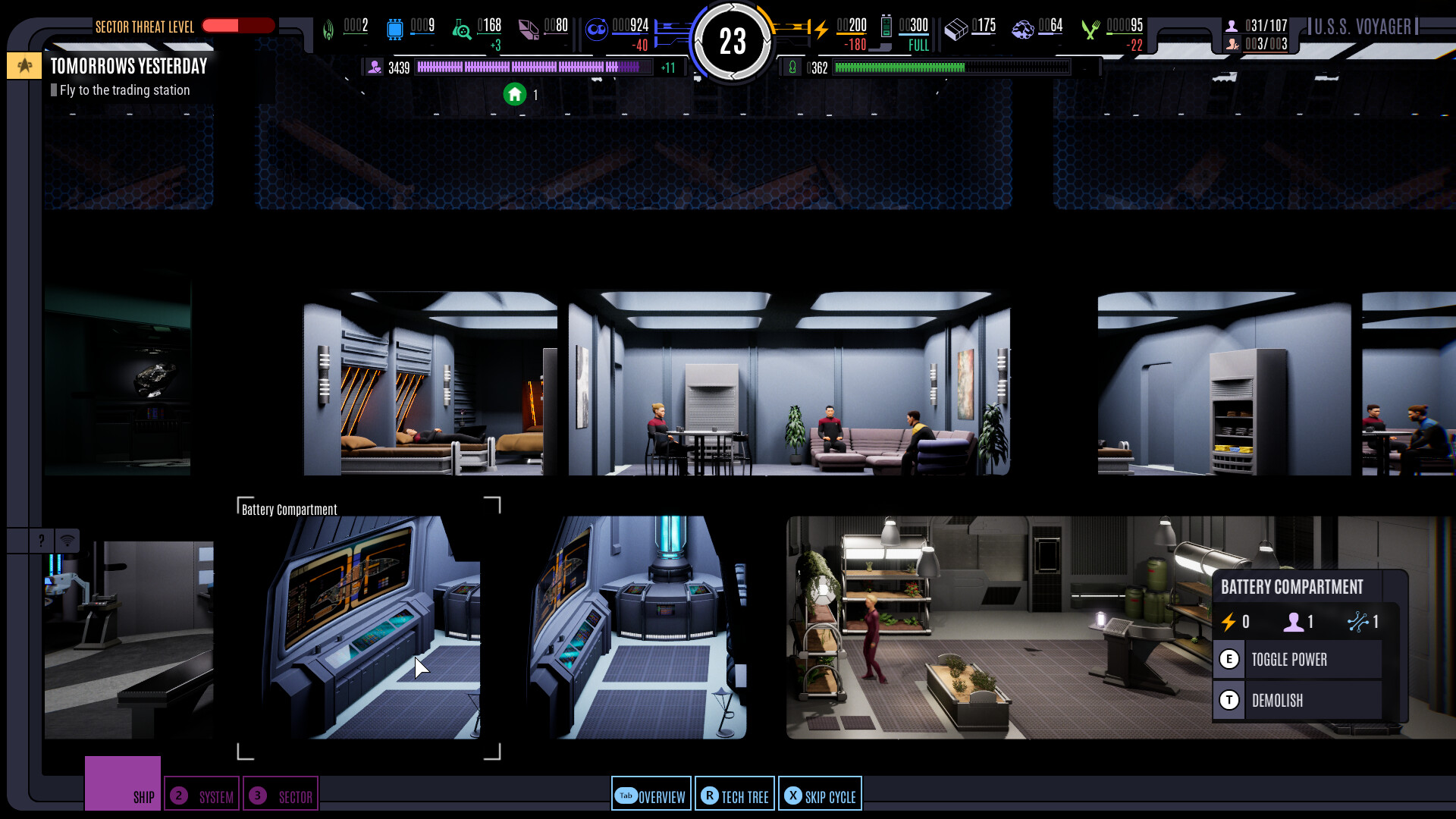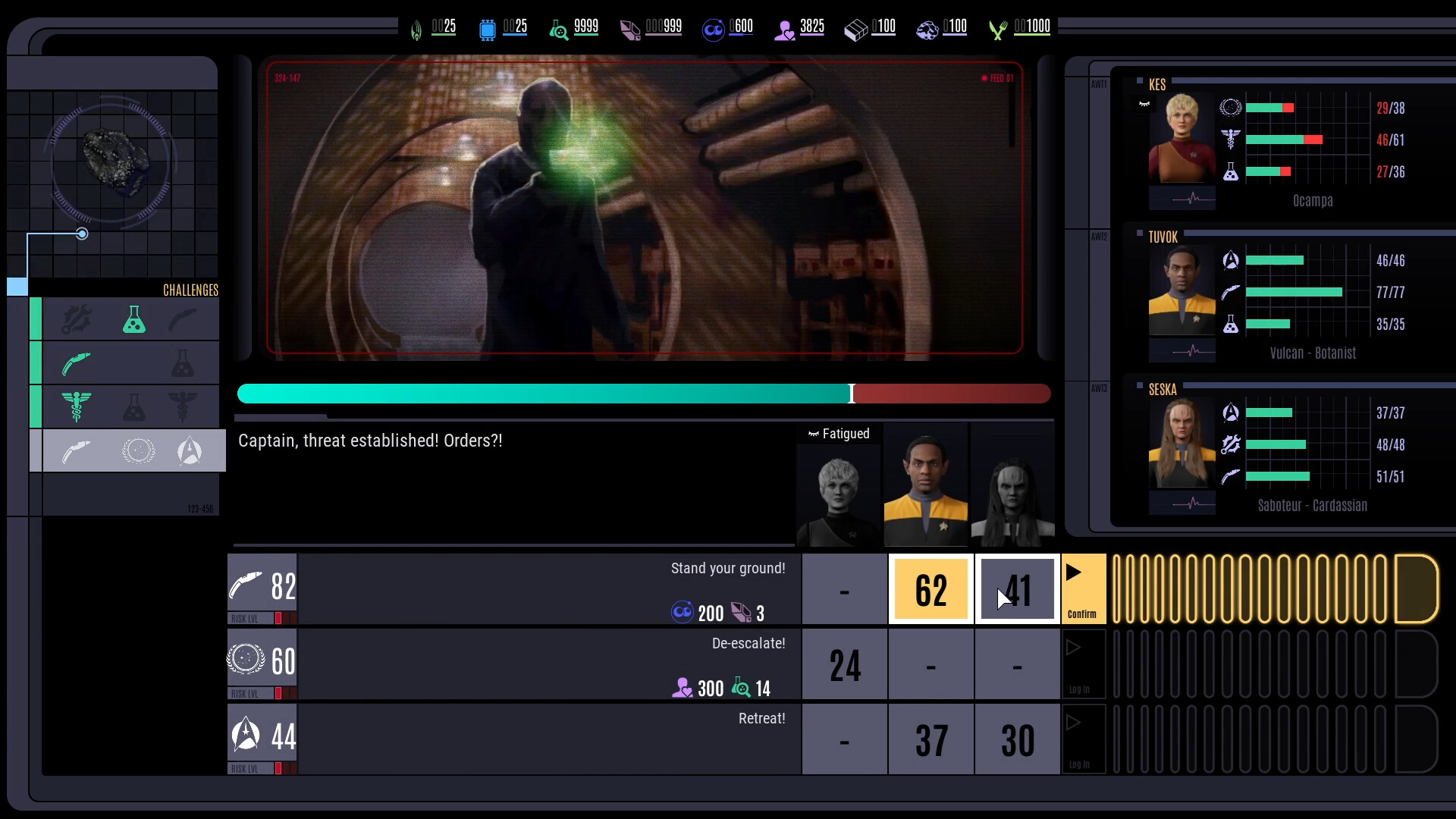Participant demographic and baseline characteristics
In this pooled analysis of 2 cohorts from 6 studies that assessed B/F/TAF in participants ≥ 50 years of age (compared with participants < 50 years of age), baseline characteristics were evaluated across both treatment-naïve and virologically suppressed cohorts (Table 1).
Among treatment-naïve participants, the median age was 55 years (quartile [Q]1, Q3: 52, 60) for those ≥ 50 years of age (n = 96) and 30 years (Q1, Q3: 25, 37) for those < 50 years of age (n = 538). This cohort included 5 participants ≥ 65 years of age, 91 participants 50 to < 65 years of age, and 538 participants < 50 years of age, for a total of 634 participants in the B/F/TAF analysis set. The majority of participants were male at birth, with 84.4% in the ≥ 50 years of age group and 90.0% in the < 50 years of age. Regionally, 58.3% of participants ≥ 50 years of age and 67.8% of those < 50 years of age were from the United States, with the remainder from other countries. Racially, 61.5% of participants ≥ 50 years of age and 56.5% of those < 50 years of age identified as White, while 31.3% and 33.7%, respectively, identified as Black. Hispanic or Latino ethnicity was reported by 11.5% of participants ≥ 50 years of age and 26.9% of those < 50 years of age. Median baseline HIV-1 RNA level was 4.48 log10 copies/mL (Q1, Q3: 4.00, 4.93) for participants ≥ 50 years of age and 4.41 log10 copies/mL (Q1, Q3: 4.00, 4.86) for those < 50 years of age. CD4 T-cell counts were similar, with a median of 436 cells/µL (Q1, Q3: 235, 601) in the ≥ 50 years of age group and 442 cells/µL (Q1, Q3: 299, 590) in the < 50 years of age group. Among participants ≥ 50 years of age, 16.7% had diabetes, 6.3% had cardiovascular disease, 40.6% had hyperlipidemia, and 47.9% had hypertension. Among participants < 50 years of age, 4.1% had diabetes, 1.5% had cardiovascular disease, 8.9% had hyperlipidemia, and 9.7% had hypertension (Table 1).
For the virologically suppressed cohort, the median age was 56 years (Q1, Q3: 52, 60) for participants ≥ 50 years of age (n = 450) and 39 years (Q1, Q3: 33, 45) for those < 50 years of age (n = 640). This cohort included 54 participants ≥ 65 years of age, 396 participants 50 to < 65 years of age, and 640 participants < 50 years of age, for a total of 1090 in the B/F/TAF safety analysis set. Most participants were male at birth, with 76.0% in the ≥ 50 years of age group and 61.4% in the < 50 years of age group. In terms of region, 72.7% of those ≥ 50 years of age and 45.9% of those < 50 years of age were from the United States. Among those ≥ 50 years of age, 64.7% of participants identified as White, 29.1% identified as Black, and 16.0% reported Hispanic or Latino ethnicity. In the < 50 years of age group, 57.7% of participants identified as White, 25.9% identified as Black, and 20.5% reported Hispanic or Latino ethnicity. Baseline virologic suppression was high, with 98.0% (441/450) of those ≥ 50 years of age and 98.8% (632/640) of those < 50 years of age having HIV-1 RNA < 50 copies/mL. Median CD4 T-cell counts were 640 cells/µL (Q1, Q3: 486, 852) for participants ≥ 50 years of age and 691 cells/µL (Q1, Q3: 523, 887) for those < 50 years of age. Medical history showed a notable prevalence of comorbidities among those ≥ 50 years of age: 11.1% of participants had cardiovascular disease, 16.9% had diabetes, 48.9% had hyperlipidemia, and 40.4% had hypertension. Among those < 50 years of age, 2.3% of participants had cardiovascular disease, 5.9% had diabetes, 18.9% had hyperlipidemia, and 17.3% had hypertension (Table 1).
Virologic Outcomes
In the treatment-naïve cohort, virologic suppression (HIV-1 RNA < 50 copies/mL) at Week 240 was achieved by 98.5% of participants (67/68) ≥ 50 years of age (95% CI: 92.1%−100.0%) and by 98.6% of participants (359/364) < 50 years of age (95% CI: 96.8%−99.6%), as determined by the M = E analysis (P = 0.9139; Fig. 1A). In the M = F analysis, virologic suppression at Week 240 was maintained by 69.8% of participants (67/96) ≥ 50 years of age (95% CI: 59.6%−78.7%) and by 66.7% of participants (359/538) < 50 years of age (95% CI: 62.6%−70.7%), with no significant differences observed between the 2 age groups (P = 0.50).
Virologic outcomes (M = E) in the treatment-naïve (A) and virologically suppressed (B) cohorts. B/F/TAF, bictegravir/emtricitabine/tenofovir alafenamide; c, copies; HIV-1, human immunodeficiency virus–1; M = E, missing = excluded. Results are shown using the M=E approach unless otherwise indicated. A Treatment-naïve cohort: the rate of virologic suppression (HIV-1 RNA<50 c/mL) with B/F/TAF was similar at Week 240 between age groups (M = E). B Virologically suppressed cohort: the rate of virologic failure (HIV-1 RNA ≥50 c/mL) was low and virologic suppression (HIV-1 RNA <50 c/mL) was high with B/F/TAF at Week 48 in both age groups (FDA Snapshot)
At Week 48 in the virologically suppressed cohort, virologic suppression (HIV-1 RNA < 50 copies/mL), as assessed by the FDA snapshot method, was achieved by 93.6% of participants, with 93.6% of participants (421/450; 95% CI: 90.9%−95.6%) ≥ 50 years of age and 93.6% of participants (599/640; 95% CI: 91.4%−95.4%) < 50 years of age achieving suppression; there were no statistically significant differences between the 2 groups (P = 1.00; Fig. 1B). The proportion of participants with HIV-1 RNA ≥ 50 copies/mL was 0.9% (4/450; 95% CI: 0.2%−2.3%) for participants ≥ 50 years of age and 1.4% (9/640; 95% CI: 0.6%−2.7%) for those < 50 years of age, with no statistically significant differences between the 2 groups (P = 0.58; Fig. 1B). At Week 48, virologic suppression (HIV-1 RNA < 50 copies/mL) was achieved by 99.3% of participants (426/429; 95% CI: 98.0%−99.9%) ≥ 50 years of age and 98.7% of participants (602/610; 95% CI: 97.4%−99.4%) < 50 years of age in the M = E analysis. The difference between the 2 age groups was not statistically significant (P = 0.54). At Week 48, virologic suppression (HIV-1 RNA < 50 copies/mL) was achieved by 94.7% of participants (426/450; 95% CI: 92.2%−96.6%) ≥ 50 years of age and 94.1% of participants (602/640; 95% CI: 91.9%−95.8%) < 50 years of age in the M = F analysis. The difference between the 2 age groups was not statistically significant (P = 0.69). No treatment-emergent resistance to B/F/TAF was observed in either age group through Week 240 in the treatment-naïve cohort or through Week 48 in the virologically suppressed cohort.
CD4 T-cell counts
At Week 240 in the treatment-naïve cohort, CD4 T-cell counts continued to increase from baseline in both age groups (mean [SD] change from baseline: +291 [221.3] for participants ≥ 50 years of age and + 347 [238.2] for those < 50 years of age; least squares mean difference [LSMD]: − 58 [range: − 120, 4]; P = 0.07). At Week 48 in the virologically suppressed cohort, CD4 T-cell count also increased from baseline among participants ≥ 50 years of age and those < 50 years of age (mean [SD] change from baseline: +18 [162.5] and + 4 [174.9] cells/µL, respectively; LSMD: 15 [range: − 7, 36]; P = 0.18), indicating no statistically significant difference between age groups.
Adherence
Adherence to B/F/TAF through Week 240 for the treatment-naïve cohort and through Week 48 for the virologically suppressed cohort is shown in Table 2. In the treatment-naïve cohort, the median adherence rate was high in both age groups, with participants ≥ 50 years of age showing a median (Q1, Q3) adherence of 98.2% (96.7, 99.4) and those < 50 years of age at 97.0% (93.2, 98.9). A greater proportion of participants ≥ 50 years of age achieved an adherence rate of ≥ 95% compared with those < 50 years of age (82.8% vs. 66.3%, respectively; P = 0.002; Table 2). In the virologically suppressed cohort, the median adherence rate was also high for both age groups at Week 48, with a median (Q1, Q3) adherence of 98.8% (96.8, 99.7) for participants ≥ 50 years of age and 98.8% (96.8, 99.7) for those < 50 years of age. The proportion of participants with adherence rates of ≥ 95%, ≥ 85 to < 95%, and < 85% was similar between age groups, indicating consistent adherence across age categories in the virologically suppressed cohort (Table 2).
Outcomes in body weight, lipid profile, renal function, and bone health
Change from baseline in body weight through Week 240 is shown for participants ≥ 50 and < 50 years of age in the treatment-naïve cohort and through Week 48 for the virologically suppressed cohort. In the treatment-naïve cohort, there were no significant overall differences in weight change at Week 240 between participants ≥ 50 years of age and those < 50 years of age. The median (Q1, Q3) weight gain was 4.8 kg (0.7, 10.2) for participants ≥ 50 years of age and 6.4 kg (2.4, 12.0) for those < 50 years of age. At Week 48 in the virologically suppressed cohort, change in body weight was minimal, with a median (Q1, Q3) weight gain of 1.5 kg (–0.8, 3.8) for participants ≥ 50 years of age and 1.8 kg (–0.4, 4.0) for those < 50 years of age. No significant difference in weight change was observed between age groups in either cohort (Table 3 and Supplement Table 1).
Change from baseline in fasting lipid parameters, specifically the TC: HDL ratio, was assessed across both age groups. At Week 240 in the treatment-naïve cohort, the median (Q1, Q3) change from baseline in TC: HDL ratio was − 0.3 (–0.9, 0.4) for participants ≥ 50 years of age and 0.1 (–0.4, 0.6) for those < 50 years of age. At Week 48 in the virologically suppressed cohort, change in the TC: HDL ratio was minimal, with a median (Q1, Q3) change of − 0.1 (–0.5, 0.4) for participants ≥ 50 years of age and 0.0 (–0.4, 0.3) for those < 50 years of age (Table 3). Additionally, the proportion of participants who initiated lipid-modifying agents during the study was higher among those ≥ 50 years of age compared with those < 50 years of age (5.3% vs. 0.8%, respectively; P < 0.0001).
Change from baseline in eGFR was similar across age groups in both the treatment-naïve and virologically suppressed cohorts. At Week 240 in the treatment-naïve cohort, the median (Q1, Q3) change in eGFR from baseline was − 10.5 mL/min (–19.6, 2.4) for participants ≥ 50 years of age and − 7.7 mL/min (–19.4, 3.0) for those < 50 years of age, with no statistically significant difference between age groups (P = 0.30). At Week 48 in the virologically suppressed cohort, the median (Q1, Q3) change in eGFR was − 0.9 mL/min (–8.1, 5.8) for participants ≥ 50 years of age and − 1.0 mL/min (–9.6, 8.4) for those < 50 years of age (P = 0.92), indicating minimal change and no significant difference across age groups (Table 3).
Change from baseline in BMD was minimal and similar between age groups in both cohorts. At Week 240 in the treatment-naïve cohort, the mean (SD) percent change in hip BMD was 0.3% (3.26%) for participants ≥ 50 years of age and − 0.4% (5.80%) for those < 50 years of age, while mean (SD) percent change in spine BMD was 1.3% (5.64%) and − 0.9% (4.95%), respectively. At Week 48 in the virologically suppressed cohort, the mean (SD) percent change in hip BMD was 0.2% (2.43%) for participants ≥ 50 years of age and 0.1% (2.03%) for those < 50 years of age; mean percent change in spine BMD increased by 0.5% (3.52%) and 0.8% (2.78%), respectively. No significant difference was observed between age groups in either cohort (Fig. 2).
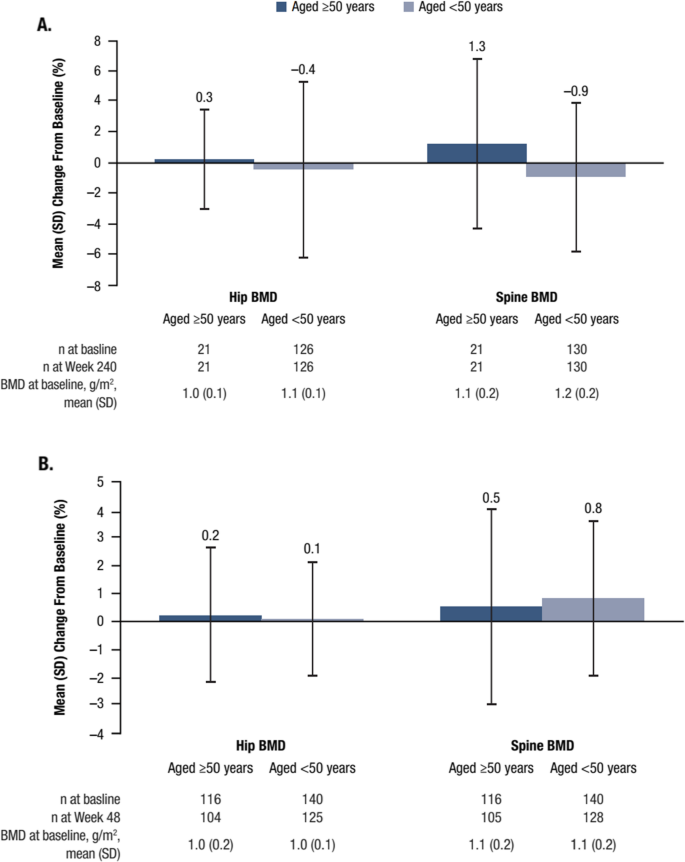
Percent change from baseline in BMD in the treatment-naïve (A) and virologically suppressed (B) cohorts. BMD, bone mineral density; SD, standard deviation. A Treatment-naïve cohort: mean percent change in hip and spine BMD from baseline to Week 240 in participants ≥50 years of age and <50 years of age. B Virologically suppressed cohort: mean percent change in hip and spine BMD from baseline to Week 48 in participants≥50 years of age and <50 years of age
Other safety outcomes
In the treatment-naïve cohort, TEAEs were reported by 93.8% of participants ≥ 50 years of age and by 95.5% of those < 50 years of age, with study drug–related TEAEs in 26.0% and 28.4% of participants, respectively. Grade 3 or 4 TEAEs affected 31.3% of participants ≥ 50 years of age and 19.0% of those < 50 years of age, with serious TEAEs in 34.4% and 19.1% of participants, respectively. Discontinuation due to TEAEs occurred in 4.2% and 1.1% of participants in the ≥ 50 and < 50 years of age groups, respectively, with 6 deaths (6.3%) among those ≥ 50 years of age and 2 deaths (0.4%) among those < 50 years of age. In the virologically suppressed cohort, TEAEs were observed in 78.7% of participants ≥ 50 years of age and in 77.2% of those < 50 years of age, with study drug–related TEAEs in 12.9% and 12.5% of each group, respectively. Grade 3 or 4 TEAEs were seen in 7.3% and 4.7% of participants ≥ 50 and < 50 years of age, respectively, with serious TEAEs in 8.7% and 4.7%. Discontinuation due to TEAEs occurred in 1.8% of participants ≥ 50 years of age and 0.9% of those < 50 years of age, with 2 deaths reported in each age group (0.4% and 0.3%, respectively; Table 4).
Treatment-emergent diabetes and hypertension
Treatment-emergent (events that occur while on study) diabetes and hypertension through Week 240 for the treatment-naïve cohort and through Week 48 for the virologically suppressed cohort are shown in Table 5. From baseline to Week 240, treatment-emergent diabetes was observed in 5.1% of participants ≥ 50 years of age and 1.7% of those < 50 years of age (P = 0.08). Treatment-emergent hypertension was reported in 19.6% of participants ≥ 50 years of age and 12.5% of those < 50 years of age (P = 0.19). At Week 48 in the virologically suppressed cohort, the incidence of treatment-emergent diabetes was 1.1% in participants ≥ 50 years of age and 1.3% in those < 50 years of age (P = 1.00), while treatment-emergent hypertension was observed in 5.2% of participants ≥ 50 years of age and 2.6% of those < 50 years of age (P = 0.07). No significant difference in rates of treatment-emergent diabetes or hypertension was found between age groups in either cohort (Table 5).
